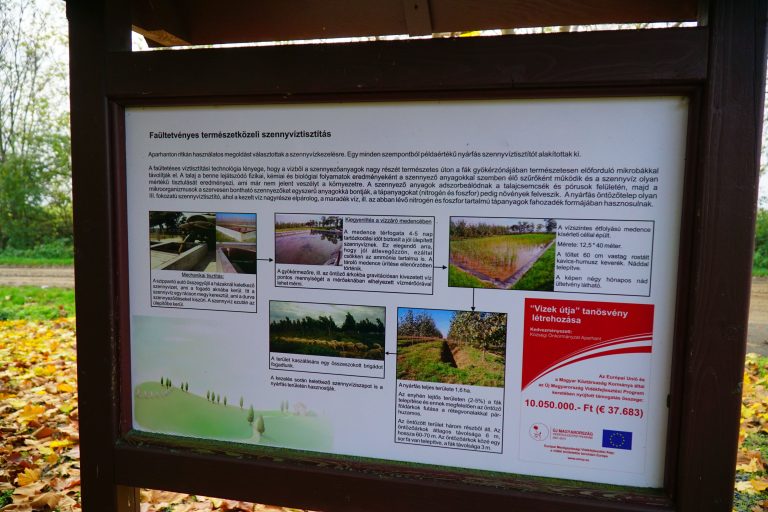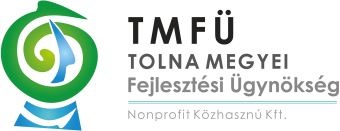Regional development and ecosystem services – the wastewater treatment plant in Aparhant
This article was created with the support of Interreg Europe project PROGRESS. The aim of the project is to initiate a process of policy change to the conservation of biodiversity and the maintaining nature’s capacity to deliver the goods and services that we all need.
Ecosystem services are often considered as natural heritage that could and should be protected from the harmful activities of humankind. Regional development activities are done with taking into account the impact on the environment but there is more to it than simply treating the two subjects as distached from each other.
Rural development, utilities and services indeed can capitalize on natural processes, taking advantage of ecosystem services in order to better utilize development funds in certain cases. Rural areas often struggle with providing specific public utilities, such as running water or wastewater treatment due to the distance and small size of the settlements effectively preventing and economical solution for implement such services. Aparhant is no different: a small village in Tolna County with about 1200 inhabitants, where the population applied simple sewage disposal solutions (cesspools) and the standard practice for emptying these digestive pits after vacuuming them out was to transport the sewage to a nearby treatment plant, a landfill or just to pour the wastewater directly into local streams. This illegal and harmful practice led to serious environmental damages; the nitrogen content of groundwater has increased and the nearby pond’s fish stocks have also become extinct. Therefore local leaders were determined to improve the situation, but the possibility of building a sewerage system was rejected due to the high costs. The municipality wanted to find an alternative and more economical system benefitting both public health and environment, while job creation and raising environmental awareness were also among the goals.

Examining the possibilities, an anaerobic lake with poplar plantation seemed to be the most efficient in terms of investment and maintenance costs, and also met environmental criteria, while reliability and low labor requirements were also accounted for. The value of the investment was 40 million HUF, while a sewage system would have cost 800 million HUF. The plant was commissioned in 2001 and ever since it sustains itself without significant expenditure; the inhabitants now have to pay 5000 HUF for emptying the digestive pits. Additional costs are the wages of twe personnel and the usage of the vacuum truck.
The site covers an area of 4 hectares at the end of the village. The first element of the system is typically a catch basin, where the wastewater of the households is poured into after collection for mechanical filtration. Then a two-storey settling basin is responsible for removing coarser contaminants and stores water. Pre-treatment is important especially when domestic wastewater is treated. Organic substances from the wastewater are dissembled by microorganisms (bacteria, fungi) in the soil. Sewage is usually poured out to the area by flooding (it flows by gravity into trenches between rows of trees). Flooding is continuous, while the sludge is removed weekly from the settling basin.

Sewage is a valuable source of plant growth, contains water, nutrients and organic matter in a suitable composition. Therefore, trees grow quickly and their nutrient utilization capacity is very good.
The process is being overseen by a monitoring system. Samples are taken after filtration from the run-off water of the settling basin, the storage basin and root zone system on a regular basis. In order to ensure that groundwater quality is not affected, monitoring wells are also in operation. The overall results have proven that pollution of nearby fields, the groundwater and the fishponds had stopped.
Compared to a sewage system this is a reasonably cheaper solution. Local household owners did not have to contribute to the cost of the investment, the municipality received development funds and donations to implement the new wastewater treatment plant, even seedlings were given as a gift by a forestry company.
The felled poplar trees can be used free of charge by the villagers. Reed growing in the aquatic plant system is cut annually and also used by the locals for various purposes, stabilized sludge is transported to a composting site every 4-6 weeks, while the composted sludge is utilized in agriculture. Grass growing between the lines of trees does not need to be mowed because a flock of sheep very conveniently does it, saving even more operational costs. Another advantage is that the students of the local primary school took part in tree planting and during biology lessons they often visit the site to become acquainted with the natural processes that take place during wastewater treatment.
The PROGRESS project is co-financed by the European Regional Development Fund and Hungary.

